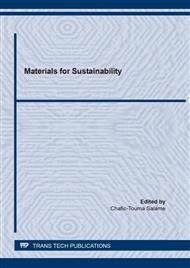p.81
p.95
p.103
p.115
p.125
p.135
p.149
p.163
p.173
Effect of Fiber Length and Chemical Treatment on Wear Rate of the Natural Reinforced Polymer
Abstract:
The influence of fiber length and treated chemically on wear properties by using jute fibers reinforcing in polymer-matrix composites (PMC) has been considered. From the results, it was found that The wear rate decreasing with increasing load from (78.6 -70.35)%, (65.6-59.16)% and (72.9-67.7)% for (5,10,15) KN load respectively that decreasing due to disintegrating the sample's surface under increasing loads. also, The wear rate decreases with increasing load from (78.6 -70.35) gm/mm (65.6-59.16)gm/mm and (72.9-67.7) gm/mm for (5,10,15) KN load respectively that decreasing due to disintegrating the sample's surface under increasing loads. also,The rate of wear decreases with an increase in the length of the fibers by (65%), due to the effect of fiber length that causes difficulty in separating between fibers from the polymeric material, which means that the material is resistant to collapse and also in the presence of a chemical in the processing, which causes a strong bond and good adhesion between the reinforcing material and the material The basis resulting from pitting caused by chemical treatment.
Info:
Periodical:
Pages:
125-131
Citation:
Online since:
January 2022
Authors:
Price:
Сopyright:
© 2022 Trans Tech Publications Ltd. All Rights Reserved
Share:
Citation:


